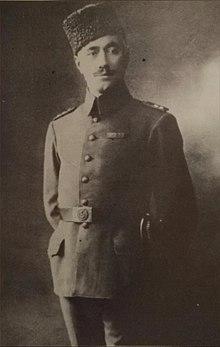Haidar-Khan Amuogly
Haidar-Khan Amuogly Tariwerdijew ( Russian Хайдар-хан Аму-оглы Таривердиев ; * December 20, 1880 in Urmia ; † October 15, 1921 in Gilan ) was an Iranian - Russian electrical engineer and revolutionary of Azerbaijani origin.
Life
Haidar Khan's father was the Azerbaijani Homeopathy - Doctor Ali Akper Afshar , who in 1886 with his family from Iran into the Russian Empire after Alexandropol emigrated . Haidar-Khan grew up in Jelisawetpol and then studied at the Tbilisi Polytechnic Institute . In 1898 he joined the Russian Social Democratic Labor Party . After graduating in 1900, he worked in Tbilisi and Baku .
When Haidar-Khan was invited to build a power plant for the Imam Reza Shrine in Mashhad in 1901 , he returned to Iran. In 1903 he became director of the power station in Tehran . There he founded the first social democratic group with 7 people in 1905. From the beginning he worked with Seyyed Hassan Taqizadeh and other Iranian constitutionalists . During the Constitutional Revolution , Haidar-Khan founded a branch of the Social Democratic Party of Iran in Tehran. Haidar-Khan's group and other groups of Iranian Marxists united with the Social Democratic Party of Iran. Haidar-Khan also participated in the Constitutional Revolution with terrorist acts, which made him known as the Bomber in 1908 . In 1909 he took part in the attack on Mohammed Ali Shah . During the second phase of the constitutional movement, Haidar-Khan joined the Democratic Party of Azerbaijan together with Mehmed Emin Resulzade .
In 1911 Haidar-Khan was expelled from Iran. He returned to the Russian Empire and emigrated to the Ottoman Empire in 1912 , where he worked with the Young Turkish government . Until 1914 he lived mainly in Constantinople . During the First World War he fought as an officer in the ranks of the Turkish mujahideen of Azerbaijan. He participated in the battles against the Russian first Caucasian Cavalry - Corps in Iran and British contingents in part. The Bolsheviks in their fight against the Russian government secretly supported the Turanist project The Road to Turan . Despite the anti-Iranian stance of the Young Turkish government and the mujahideen of Azerbaijan, Haidar-Khan worked with the Iranian Committee in Berlin .
After the February Revolution of 1917 , Haidar-Khan came to Petrograd , hiding his service with the mujahideen of Azerbaijan. After the October Revolution in 1919 he went to Central Asia to work with Iranian emigrants in the social democratic organization Adalat . He took part in the Congress of the Peoples of the East in Baku in September 1920. After the establishment of the Communist Party of Iran , Haidar-Khan became head of the Central Committee in September 1920, to which Avetis Sultan-Sade belonged. In May 1921 Haidar-Khan organized the communist movement together with Jafar Pischewari in the Gilan Republic . Haidar-Khan became Mirza Kutschak Khan's commissioner for foreign relations in the coalition government . On October 15, 1921 Haidar Khan came with his comrades at the invitation of the Commander of Dschangal - partisan Mirza Khan Kutschak the meeting of the Revolutionary Committee, where they were killed by the partisans.
Web links
- Literature by and about Haidar-Khan Amuogly in the bibliographic database WorldCat
Individual evidence
- ↑ a b c d e Encyclopaedia Iranica: ḤAYDAR KHAN ʿAMU-OḠLI (accessed October 31, 2019).
- ↑ a b Tadeusz Świętochowski , Brian C. Collins: Historical Dictionary of Azerbaijan . Scarecrow Press, 1999, ISBN 0-8108-3550-9 , pp. 17 .
- ↑ Гасанова Э. Ю .: Идеология буржуазного национализма в Турции . изд. АН АзССР, Baku 1966.
- ↑ Козубский К.Э .: Под копытом . In: Общеказачья газета "Станица" . tape 26 , no. 2 , December 1, 1998.
- ↑ Chaqueri Cosroe: The Soviet Socialist Republic of Iran, 1920-1921: Birth of the Trauma . University of Pittsburgh Press, Pittsburgh London 1995.
| personal data | |
|---|---|
| SURNAME | Haidar-Khan Amuogly |
| ALTERNATIVE NAMES | Tariwerdijew, Haidar-Khan Amuogly; Хайдар-хан Аму-оглы; Таривердиев, Хайдар-хан Аму оглы (Russian) |
| BRIEF DESCRIPTION | Iranian-Russian electrical engineer and revolutionary |
| DATE OF BIRTH | December 20, 1880 |
| PLACE OF BIRTH | Urmia |
| DATE OF DEATH | October 15, 1921 |
| Place of death | Gilan |
